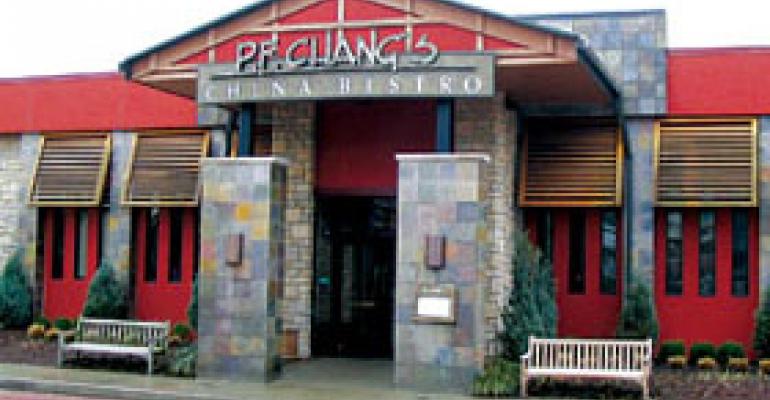In the three-plus years since casual-dining guest traffic started to decline, operators have tightened their belts and cut costs to shore up their bottom lines. But with no economic relief in sight, and attempted quick fixes for eroding bottom lines already in place, many now are turning to what some experts see as the chains’ only option: pulling out all the stops to get guests back in seats.
From stepped-up marketing campaigns to more limited-time offers, new menu items and delivery and to-go programs, casual operators are working overtime to reverse the negative traffic trends that continue to dog them. And they’re keenly aware their task isn’t easy.
(To view charts featured in this week's print pages, click here.)
On average, the same-store sales of publicly owned casual-dining chains fell 5.6 percent for the the three months that ended on or about Sept. 30, compared with year-earlier results, according to Nation’s Restaurant News research. That drop follows a decrease of 2.4 percent in the second quarter, which falls to an average 3.1 percent if Buffalo Wild Wings’ positive results are factored out. Similar trends are apparent going back to the first quarter of 2006.
The prolonged casual-dining sales slump, which has led to reduced revenues, falling profits and some bankruptcies, was first met head-on by cuts to costs, development and personnel in the name of preserving the bottom line. By now, however, the quick fixes have been made, and chains across the segment are trying to survive mostly by uncertain bids to drive sales, which many agree is not a good position to be in. One restaurant executive even called September traffic trends “just plain ugly.”
“Over the first one, two or even three years of traffic declines, restaurant companies can employ various techniques to minimize [sales] deleverage,” said David Palmer at UBS Equity Research in New York. “Many of these…chains are running out of options…as they head into 2009.”
Palmer cited reduced or more efficiently scheduled labor, a tightened supply chain, corporate overhead cuts, and menu price increases as the efforts most commonly used to battle sales deleverage, or the large impact of reduced sales that trickles down to a company’s bottom line. With those efforts already completed, restaurant companies must rely on getting customers in the door.
“If we could ever get sales moving in the right direction again, I think we are probably more efficient today than we’ve ever been,” said Robert Vivian, president of P.F. Chang’s China Bistro, a 182-unit chain.
That could be a large “if,” say restaurant executives and analysts, who almost uniformly have predicted a tough holiday season and very little consumer rebound through next year. The reasons are well known: a recessionary economy, weak consumer confidence, the uncertain outcome of the presidential election, and the banking and financial crisis.
P.F. Chang’s said its fourth-quarter average weekly sales at the namesake chain are expected to drop 5 percent from a year ago, the chain’s highest-ever rate of decline. Brinker, one of the largest casual-dining companies with its four brands and more than 1,900 restaurants, said it doesn’t expect a change in the negative trajectory of the economy or the casual-dining sector for at least its current fiscal year, which ends in June 2009.
The Cheesecake Factory Inc. and BJ’s Restaurants Inc. also said last month that sales-driving initiatives will include increased marketing, limited-time offers at lower price points, and added emphasis on takeout or delivery options.
Scottsdale, Ariz.-based P.F. Chang’s, which also operates the 165-unit, fast-casual Pei Wei Asian Diner, said it would continue to use advertising strategies like direct mail, billboards, online campaigns and radio spots to help spark sales. The company, typically not a large advertiser, has doubled the total advertising spending at both concepts this year to about $12 million.
“In a tough economic environment,” said Mark Mumford, the company’s chief financial officer, “when consumers are even more discriminating about choosing who they spend their hard dollars with, it’s more important to communicate with them.”
At The Cheesecake Factory Inc., another casual-dining operator that typically does not advertise heavily, the company is working to formalize an approach for both its namesake chain and the Grand Lux Cafe brand, which together total 157 locations. Earlier this year, the company initiated a campaign around National Cheese-cake Day, when each location provided a slice of cheesecake per customer for $1.50, the same price cheesecakes were sold at when the chain’s first restaurant opened in 1978. The event increased guest traffic significantly, executives said.
Late last month the company introduced a guest card program aimed at increasing incremental visits. After dining, the guest card offers rewards like a $10 discount or an extra slice of cheesecake on a return visit. A similar program was introduced this summer at California Pizza Kitchen, and executives there said it was successful. The Cheesecake Factory, which is based in Calabasas Hills, Calif., also is increasing the number of locations under its delivery service test, it said.
BJ’s Restaurants Inc. is using several techniques to drive traffic, including additional spending on electronic media, a focus on its curbside to-go initiative, online ordering, call-ahead seating and expanded delivery. The Huntington Beach, Calif.-based company said its curbside to-go program already has increased off-premise sales by about 0.5 percent.
Brinker said it would continue to work on menu innovation and limited-time offers. Newer items, like the Big Mouth Bites at Chili’s Grill & Bar and grilled enchiladas at On the Border have become lead sellers, said officials at the Dallas-based company. Chili’s also has been able to maintain a slower decline in lunch traffic, a soft spot for the sector, with its Bottomless Express Lunch promotion.




